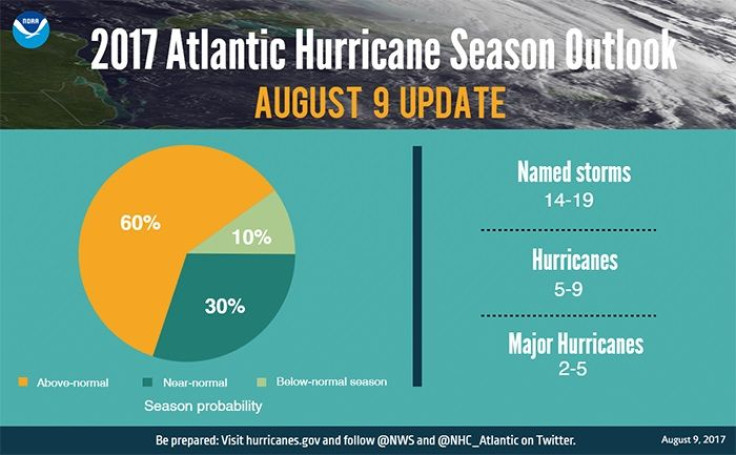Hurricane Season 2017: NOAA Predicting Above Normal Season

Less than half way through the 2017 hurricane season the National Oceanic and Atmospheric Administration has upgraded the chances of an above-normal season in the Atlantic. In May, NOAA had estimated that the chance of an above-normal season was about 45 percent. Now the chance of an above-normal season is set at about 60 percent.
This change came in part due to the fact that during the first nine weeks of the season there were six named storms, accounting for half of those budgeted for the entire season. One of those storms was Tropical Storm Emily that brought major flooding to Florida just two weeks ago. Additionally, as the chances of an El Nino forming have decreased since May, the chances of a stronger unsurpassed hurricane season have increased.
Read: When Does Hurricane Season Start? Atlantic, Pacific Storm Forecasts Predict Many Cyclones
Forecasters are now predicting that the season will be extremely active, possibly comparable to the 2010 season. In May, NOAA was predicting 11 to 17 named storms for the season, a range that has been upped to 14 to 19. The prediction is that those 14 to 19 storms will include two to five major hurricanes, and five to nine hurricanes.
A storm gets a name when it progresses from a tropical depression, with maximum wind speeds of 38 miles per hour, into a tropical storm, with maximum speeds of 73 miles per hour. Once a storm reaches wind speeds higher than this is becomes a hurricane or typhoon, according to the National Hurricane Center at NOAA.
For the Atlantic, there are six lists of names used for the storms and they’re recirculated every six years. If a name is used for a particularly deadly or expensive storm, those names are then retired and replaced. The names are used to clearly identify storms with easy names to pronounce that are unique and difficult to mistake for other names. The Pacific has its own lists of names.
Read: Sea Level Rise Accelerating In Southeast US Due To 'Hot Spots'
So far during the 2017 season, six names have been used of the 21 names on the list. The season usually picks up in late August going into the cooler fall months, when storms are more frequent and strongest, said NOAA.
“As we enter the height of hurricane season, it’s important for everyone to know who issues evacuation orders in their community, heed the warnings, update their insurance and have a preparedness plan,” Brock Long, Federal Emergency Management Agency administrator, told NOAA.
© Copyright IBTimes 2024. All rights reserved.











